 |
Catholic Customs
How to Address Priests and Religious:
Titles and Signs of Respect
Marian Therese Horvat, Ph.D.
Before me are several interesting questions on how we should address priests and religious men and women sent to my desk recently by a lady. I will answer them today on the TIA website, since I think that my correspondent is not the only one with similar queries.
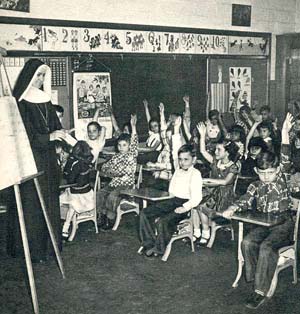
The dignified sisters inspired respect. Above, a sister teaches protocol in a pre-Vatican II Catholic classroom.
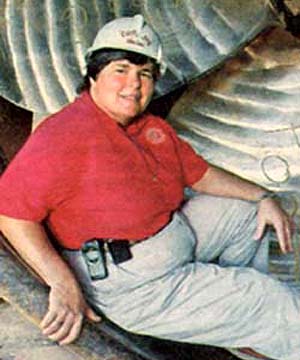
After the Council, sisters abandoned the habit and took up jobs in the world. Above, Sister Joy Manthey "ministers" to riverboat captains and crews. Parade Magazine, Dec. 9, 2001 |
In times past every Catholic used to know some of the simple rules that have been set aside from disuse. The general protocol was taught by sisters in grade school, but more often was learned as in osmosis from everyday practice. No one dreamed of calling Father O’Reilly by the nickname “Bill,” or, addressing Sister Margaret Mary as “Maggie.” Everyone knew you rose as a sign of respect when a priest or religious entered the room. Speaking before a gathering that included clergy or religious, a Catholic speaker as habit addressed them solemnly first.
But then came the tumultuous and leveling aftermath of Vatican II that spelled a death to formalities in the religious sphere. Priests, monks and sisters began to adopt the ways of a world that were becoming increasingly vulgar and egalitarian. Distinguishing titles and marks of respect were considered alienating and only for old-fashioned “establishment” people who were afraid to embrace the “signs of the times.”
In the spirit of adaptation to the world, the cassock and habit were abandoned, along with the formal signs of respect paid to the persons who wore them. Confusion set in: what do you call a nun in a pants suit who says, “Just call me Ann,” or a priest in a western shirt and cowboy boots, who says, “You can call me Cowboy Bob”? No, I’m not making that last one up.
This leveling egalitarian spirit violates not only tradition and the laws of civility, but also the practice of justice. We need only look to a basic principle of Roman Law, so coherent in its logic, which states that that each one should be given what he has a right to receive. Because people are unequal in status, situation, and talent, the necessity of justice demands unequal treatment. Catholic doctrine used to be applied concretely in Christian Civilization. Thus one could judge a person according to a code of rights, merits and honors, and according to this code, use a formula of respect suitable for each one and each occasion.
It is a great good to know how to give respectful treatment to a superior. Reciprocally, those in higher positions have a duty of justice to treat those below them with dignity and consideration. Let me give a charming example from our Catholic past: King Louis XIV took off his hat for every woman, even if she were a simple housemaid. But he did not remove it for a man unless he were a member of the clergy or a royal family. For a man with a Catholic spirit, this hierarchical order of dignities provides a kind of oxygen that makes it easier to breathe.
Addressing priests and religious
Today, some serious Catholics are doing more than reminiscing about those “good old days.” Aware of the importance of not only exterior demeanor and symbols, but also the ways of treatment and address that were accorded to religious as their just due, they would like to return to the basic courtesies. It is a very positive step.
Let me turn, then, to the first question:
1. Should we call a priest by his first name or last name? I can remember in elementary school all the priests went by their last names, but now they seem to want to be called by their first.
The answer is simple. Father William Walters should be addressed as Father Walters or as Father, not as Father Bill, and certainly not as Bill. In the really old times, to which I would like to return, you would address him as Your Reverence.
In addressing an envelope to a priest you would write The Reverend Father William Walters, or The Reverend William Walters. Don’t forget the The. If you want to be more polite you could use His Reverence.
If the letter is formal, the salutation would be The Reverend Father Walter; for a personal letter, the salutation would be Father Walters, or if you know him better, Dear Father Walters.
If you are writing to priest who is a member of a religious order, you would add the initials of his community after his name, e.g. The Reverend Philip Amato, O.F.M. , or The Reverend Father Philip Amato, O.F.M. (1) A brother, one who has taken the vows of poverty, chastity and obedience in an order but has not received the Sacrament of Holy Orders, should always be called Brother, not Father. In written address, his initials would also follow his name, e.g., Brother Francis Marie, O.F.M.
It is my first choice to maintain the address Father William Walters or The Reverend Father William Walters in preference to simply The Reverend in the formal or written address. Since most Protestant ministers are addressed as “the reverend,” this puts a healthy distinction between the Catholic priest and the Protestant preacher, and does not place the priest on the same level as men who are not Catholic.
For the same reason, it is inconvenient for a Catholic to call a Protestant preacher “reverend,” because this is to indirectly confer legitimacy to his heretical confession. It is much better to call a Lutheran Mr. Jones instead of reverend Jones, or use the title Doctor or Professor, if it is applicable. In writing, it is sometimes necessary to refer to a Protestant as bishop, but the title should be lower case, e.g. bishop Philip Robinson, or Protestant bishop Robinson, as a sign of differentiation from the Catholic Bishop.
We Americans have the duty to be especially vigilant regarding tolerance toward Protestantism. It was such tolerance that produced the heresy of Americanism, which in final analysis, is to adapt Catholic doctrine and practices to Protestantism. Unfortunately that same penchant that induced Leo XIII to write against Americanism is still alive today not only among progressivist Catholics, but even among conservative or traditionalist American Catholics.
The same general rule regarding Protestants – that is, to avoid the religious title in direct address – would apply to the hierarchy in other heretical or schismatic confessions. If a title is used in writing, it should be lower case, e.g. rabbi Jacob Levinsky, or for an “orthodox” bishop, bishop Michael Baldwin, etc.
The rules simply stated
Going up the Catholic hierarchical ladder, these are the basic rules to serve you in day-to-day circumstances:
Deacons
Direct address: Deacon Morris
Written address: Reverend Deacon Michael Morris
Formal introduction: The Reverend Deacon Michael Morris
[Note: Deacons, from the Greek diakonos meaning servant, are those who received the lowest of the major orders of priesthood: deacon, priest and Bishop. The minor orders are: porter, lector, exorcist and acolyte.
The role of deacons has varied through the History of Church. In the early period, they were numerous and exercised many different functions, either as assistants in the celebration of the Mass or for various practical services of the Church. Later, in the Latin Rite, their role diminished and almost disappeared, and the deacon became just an intermediary step for the priesthood.
The Council of Trent considered restoring permanent deacons, but did not do so. After the Second Vatican Council, given the shortage of priests, permanent deacons were restored to help maintain the flock.}
Brother
Direct address: Brother Elias.
Written address: Brother Elias, O.F.M.
Formal introduction: Brother Elias of the Order of Friars Minor.
Religious Priest
Direct address: Father McKenzie, or Father.
Written address: The Reverend Father Leo F. McKenzie, S.J.
Formal introduction: The Reverend Father Leo McKenzie of The Society of Jesus.
Diocesan Priest
Direct address: Father Butler, or Father.
Written address: The Reverend Father John W. Butler.
Formal introduction: The Reverend Father John Butler.
Protocol: Stand when a Priest enters the room, and remain standing until he invites you to sit. Men should remove their hats in his presence. A good custom at greeting the Priest is to kiss his hand, to honor the fact that they conescrate the Holy Eucharist. The same signs of respect should be given shen leaving his presence.
Vicars, canons, provincials, deans and rectors
Direct address: Reverend Smith or Father Smith
Written address: The Very Reverend Father Provincial Thomas R. Smith
(ab. The Very Rev.)
Formal introduction: The Very Reverend Vicar General James Dean
Protocol: the same as for Priests.
Monsignor
Direct address: Monsignor Smith, or Monsignor.
Written address: The Reverend Monsignor Thomas R. Smith, or The Reverend Monsignor Thomas R. Smith.
Formal introduction: The Reverend Monsignor Thomas Smith.
Protocol: the same as for Priests.
Bishop (2)
Direct address: Your Excellency, or Bishop McNeil.
Written address: His Excellency, The Right Reverend William A. Scully, D.D. Bishop of Baltimore. or His Excellency, The Right Reverend Bishop William Scully of Baltimore.
Formal closing: Kissing the Sacred Ring,
Formal introduction: His Excellency, the Bishop of Baltimore.
Protocol: Stand when a Bishop enters the room, and remain standing until he invites you to sit. Men should remove their hats in his presence. For your own Bishop, you may kneel on your left knee and kiss his ring as a sign of respect for his office. If kneeling would be ackward, or if it is not your own Bishop, you may bow at the waist and kiss his ring. Do not do either if the Pope is present. The same signs of respect should be given when leaving his presence.
Archbishop
Direct address: Your Grace, or Archbishop Kovak.
Written address: His Grace, The Most Reverend Michael T. Kovak, S.T.D. Archbishop of New York, or His Grace, The Most Reverend Archbishop Michael T. Kovak, of New York.
Formal closing: Kissing the Sacred Ring,
Formal introduction: His Grace, the Archbishop of Baltimore.
Protocol: The same as for a Bishop.
Patriarch
Direct address: Your Beatitude.
* Note: the Patriarch of Lisbon is addressed as "Your Eminence"
Written address: His Beatitude, the Most Reverend Michael Cardinal Sabbah, Patriarch of Jerusalem.
Formal introduction: His Beatitude, The Patriarch of Jerusalem.
Protocol: The same as for a Bishop.
Cardinal
Direct address: Your Eminence, or Cardinal Hand.
Written address: His Eminence, Thomas Cardinal Hand, Archbishop of Los Angeles, or, His Eminence, The Most Reverend Cardinal Thomas J. Hand, of Los Angeles.
Formal closing: Kissing the Sacred Purple,
Formal introduction: His Eminence, Cardinal of Los Angeles.
Protocol: The same as for a Bishop.
Pope
Direct address: Your Holiness, or Holy Father.
Written address: His Holiness, Pope Pius XII, or better, The Sovereign Pontiff, His Holiness Pius XII.
Formal closing: Kissing the Sacred Foot,
Formal introduction: His Holiness, the Pope.
Protocol: After being introduced, kneel on your left knee and kiss his ring as a sign of respect for his office. Stand when the Pope enters the room, and remain standing unless he invites you to sit. Men should be wearing a suit coat and tie and remove their hats in his presence. Women should wear black dresses and have their heads and arms covered. The same signs of respect should be given when leaving his presence.
If you bring a new white zucchetto with you at a scheduled meeting with the Pope, a customary gesture of amiability is for His Holiness to trade the one he is wearing for the one you offer.
Abbreviations
Abbreviations should follow this form:
Brother – Bro., or Br.;
Abbot – Ab.;
Father – Fr., or F. (plural – FF.);
Reverend Father – R.P. (Reverendus pater), or more often, Rev. Fr.;
Right Reverend, Most Reverend – RR. (Reverendissimus)
Monsignor – Msgr. or Mgr.;
Bishop – Ep., Epus. (Episcopus);
Archbishop – Archieps. (Archiepiscopus), or Arch.;
His Eminence – H.E.;
Eminence – Emus. (Eminentissimus)
His Holiness – H.H.
How should religious women be addressed?
Great respect used to be accorded to every religious woman, whose life, one knew, was one of constant self-sacrifice. Her habit was a sign of her vow of poverty and renunciation of normal vanities and pleasures as well as her perfect chastity. It also was a symbol of her life of obedience, which demanded a constant renunciation of her self-will.
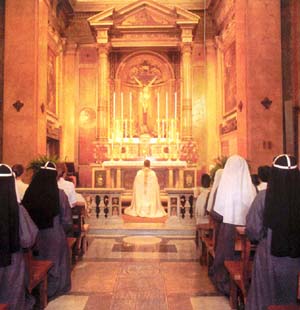
Bridgettine nuns in their beautiful traditional habits pray before the Blessed Sacrament in a church in Sweden
Inside the Vatican, February 1996 |
While the terms nun and sister are interchangeable in the United States, Catholics should always address a religious woman as Sister: Sister Angela Marie. Like the simple brothers, the sisters are not distinguished by any special titles.
Often the superior of a religious house is called Mother. The titles can vary: Mother Superior, Mother Prioress, Mother Abbess, or for all of them you can simply say Reverend Mother or Your Reverence. The written address would be The Reverend Mother Catherine Marie of the Incarnation, O.C.D., or The Mother Abbess Margaret of the Sacred Heart. O.S.B., with the initials of the community added after the name.
Above, I gave some examples using the beautiful religious names sisters used to receive with the hope that there will be a return to the inspiring practice of leaving aside the name one had in the world to assume another as the spouse of Christ. Unfortunately, after Vatican II an increasing number of convents and monasteries have abandoned this practice and no longer assign their novices a new name in Christ as a sign of their renunciation of the world.
The rules simply stated
Sister
Direct address: Sister Anthony Christine, or Sister.
Written address: Sister Anthony Christine, D.S.P.
Formal introduction: Sister Anthony Christine of the Daughters of St. Paul.
Mother Superior
Direct address: Reverend Mother Francis Louise, Reverend Mother, or Your Reverence.
Written address: The Reverend Mother Francis Louise, D.C.
Formal introduction: The Reverend Mother Francis Louise of the Daughters of Charity of St. Vincent de Paul.
Abbreviations
Sister – Sr. (Soror);
Abbess – Ab.;
Reverend Mother – Rev. Mother.
What if a priest insists?
What do you do when the Father George O’Reilly wants to be called “Father George” and insists with you, or your children, on being addressed as such?
There is, of course, the American way of being blunt and honest, which would dictate an open confrontation about the modern tendencies of the address. “I just told Father what I thought about it,” the American might later boast. You can follow this school if you feel it necessary, but it is a bit gauche. The laws of courtesy we are aiming to restore would counsel us not to be party to that spirit, which can often leave ugly wounds in its bluntness and cross the line of honesty into rudeness. Here, it would be much better to employ a more subtle, and more Catholic behavior.
It is not difficult for an adult to calmly resolve the situation. One does not need to argue, protest, or correct. Continue to address the priest as Father O’Reilly, as the Church always taught us to do in English-speaking countries, and should he persist in his demands for less formality, explain simply that this is your preference. This should suffice given the reverence today’s society affords the argument of personal preference.
In the case of a priest insisting with a child on less formality, a parent should intervene and speak discreetly to the priest: “Father, I am asking you the favor of not insisting that my child call you “George,” since this isn’t the custom in our family. I would appreciate your help and support in this.” Only rarely, in the case of extreme revolutionary bad will, is more than this necessary.
Children will naturally emulate the daily habits, manners, and attitudes of their parents. So the best way to instill the laws of civility as second nature in children is for parents to do what they want their children to emulate. A boy or girl whose father and mother are unfailingly courteous and considerate of Priests, Brothers and Sisters knows instinctively both how to act and that the religious vocation is respected. Here the Latin adage applies: verba docent, exempla trahunt. Freely translated it means: words teach, but it is example that makes the impact.
Other normal signs of respect
Because of the great dignity of the priest due to his sacred mission, a special respect is owed him in social life. Men, women and children should rise when a priest enters the room, and remain standing when speaking to him if it is a brief contact. If it is a longer visit, after a cordial greeting all present can be seated, giving the priest the place of honor.
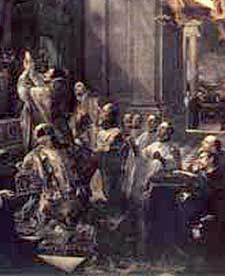
Because of sacred mission of the priest, a special respect is owed him in social life
Inside the Vatican, February 1996 |
I remember so well that whenever the priest would enter the room in my parochial grade school, we would all rise and at a sign from Sister, greet him in unison, “Good morning, Father Kelly.” At another sign, we could sit down again. What order and serenity the observance of these small conventions guarantees even the small society of a classroom.
Back when men and boys more regularly wore real hats, they would remove them and remain uncovered in the presence of a religious or cleric. Today the ubiquitous baseball cap at least should be removed.
American manners have almost always been a bit rough – perhaps because of our tendency to celebrate the spontaneous spirit, and more probably because of a general egalitarian spirit that disdains class distinctions. At any rate, I am convinced most young Americans today truly are unaware that there is a proper order and seating arrangement to be following at Catholic gatherings and home dinner parties. At a baptismal or wedding party or a meeting of a Catholic organization, for example, a clergy present should be treated as guests of honors and in normal circunstances occupy the seat of honor. That place is at the right of the host or hostess, or chairman.
When several clergy are present, the position of honor is determined by rank in the hierarchy, or seniority. Thus, a Bishop takes precedence over a priest, priests take precedence over brothers, and brothers over sisters, an older priest over a younger.
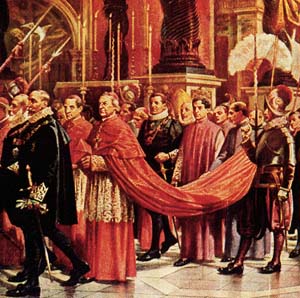
The hierarhcial order is followed in ceremonial processions involving the clergy. Above, a Cardinal's majestic cape is solemnly carried. |
For example, at a family dinner celebration at which a Monsignor and a priest are present, the Monsignor would be seated at the right side of the host or hostess, the priest at the left. According to the American etiquette books, the guest of honor would always be placed on the right and left of the hostess. But it is very common practice in Latin countries, and I believe a more organic custom, for a priest to be seated at the right side of the host, that is, the father, who is head of the family. Often, he will even cede his place to the priest, and especially to a Bishop, as a sign of respect and deference.
A mother can help a child to understand this hierarchical order in a very normal and natural way as she prepares for a dinner party and “preps” the family members:
“Mark, please set the table – remember, Father Burns will be sitting at your father’s right. Be sure to stand when Father enters and greet him, ‘Good evening, Father.’ Please don’t just say, 'Hi.' That’s what children without good manners do. And don’t forget to excuse yourself from the table, and when you have permission to leave, tell Father good night and that you enjoyed the evening.”
This kind of day-to-day manners class cultivates a courtesy that is effortless and genuine, which is what good manners by definition are.
Treatment of a Bishop
There is a special protocol for formally greeting a Bishop that needs to be dusted off and put back into daily usage. Because a Bishop has received the fullness of Holy Orders, that is, the power to administer confirmation and Holy Orders as well as all the other Sacraments, he receives a special distinction. He is a Prince of the Church and a Successor of the Apostles.
A Catholic formally greets a Bishop by kissing the ring on his right hand, one of his marks of office. Should circumstances permit, one kneels on one knee to kiss his ring. Kneeling on both knees as a mark of respect is reserved for the Blessed Sacrament when it is exposed.
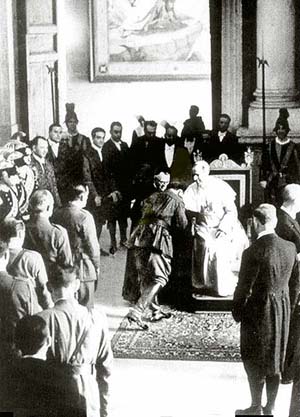
Spanish officers pay ceremonial homage to the Pontiff in a private audience at the Vatican, 1939 |
If the circumstances make it difficult or gauche to kneel, it is appropriate to make a small sign of deference, standing and bending forward slightly from the waist to bring your lips to the ring of the Bishop, whose hand rests lightly in yours.
Do not be surprised if some Bishops step away from this proper address you offer. Today this formal address is avoided or shunned by many Bishops, influenced by the egalitarian spirit of Vatican II that calls for a “less vertical and more horizontal” Church. But this does not render such courtesies either improper or obsolete. Consider this advice from American Catholic Etiquette written in 1962:
“It is never wrong, either from a religious or social point of view, to greet a Bishop by kissing his ring. It is done at weddings, funerals, ordinations, any entertaining at which the Bishop is the host, or meetings of Catholic organizations…
“No layman, religious or cleric below the rank of Bishop sits in the presence of a Bishop until he invites one to do so. If seated, one rises when a Bishop approaches to address one and remains standing until he invites one to be seated.
“At a social gathering, the host, hostess or chairman says to the Bishop before all others present, ‘Please be seated, Your Excellency,’ and indicates a seat on his (her) right. If the Bishop arrives after the other guests, all rise when he enters and remains standing until he is seated.” (3)
These marks of respect should also be shown to clerics and religious by the laity, with the exception of kneeling before priests. Post-Vatican II Americans can be surprised to learn that a good custom still followed in well-bred Catholic circles is to kiss the hand of a priest in greeting him, as a signal of respect for the hand that consecrates in the Holy Sacrifice of the Mass.
The Vatican II leveling spirit conflicts with Catholic tradition
The relaxed and vulgar new attitude in both the treatment and way of being of ecclesiastics has produced bad fruits: disrespect, impoliteness, rudeness, and a great loss of the dignity and sacrality that characterize the religious life. In fact, this modern spirit conflicts with age-old Church teaching on the spiritual life, which counsels that Catholic principles should be applied not only in strictly spiritual matters, but also in the familiar and social life. Catholic perfection also extends to these fields of human activity.
Confirming this, St. Bonaventure argued that the interior life is acquired and preserved through the exterior. Just as in nature, he said, there is never a tree without its leaves and bark, nor a fruit without its rind or husk to serve as protection, so also interior recollection is preserved by the exterior demeanor and ways of being and treatment. When the exterior fails, the other fails also. (4) The reckless experiment of the last decades after Vatican II has proven the truth of his words.
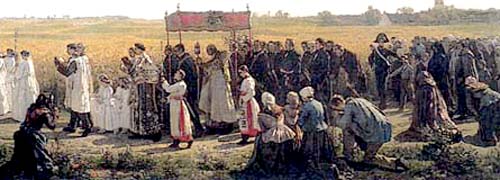
In Courbet's magnificent painting, The Blessing (La Benedicion), one can see the ceremonial life
of Christian Civilization embraced and practiced by the people.
In the picture, the villagers pay profound homage to the Blessed Sacrament
and the clergy in the ceremony of the blessing of the fields.

Some common religious institutes of men in the United States
C.J.M. – Congregation of Jesus and Mary (Eudists)
C.M. – The Congregation of the Mission (Vincentians or Lazarists)
C.M.F. – Missionary Sons of the Immaculate Heart of Mary (Claretians)
C.P. – The congregation of the Passion (Passionists)
C.S.C. – Congregation of the Holy Cross (Holy Cross Fathers)
C.S.P. – Congregation of St. Paul (Paulists)
C.SS.R. - Congregation of the Most Holy Redeemer (Redemptorists)
C.SS.S. – Congregation of the Most Holy Savior (Brigettines)
F.S.C. - Brothers of the Christian Schools (Christian Brothers)
F.S.P.X. - Fraternity of St. Pius X
F.S.S.P – Priestly Fraternity of St. Peter
L.C. – Legionaries of Christ
O.C. or O.Carm. - Order of Carmelites
O.Cart. – Order of Carthusians
O.Cist. – Order of Cistercians
O.C.D. – Order of Discalced (Barefooted) Carmelites
O.C.S.O. - Order of Cistercians of the Strict Observance (Trappists)
O.F.M. – Order of Friars Minor (Franciscans)
O.M.I. – Oblates of Mary Immaculate
O.P. – Order of Friars Preachers (Dominicans)
O.S.A. – Order of St. Augustine (Augustianians)
O.S.B. – Order of St. Benedict (Benedictines)
O.S.F. – Franciscan Brothers
O.S.J.D. – The Order of St. John of God (Brothers of Mercy, or Mercederians)
S.V.P. – Society of St. Vincent de Paul
S.J. - Society of Jesus (Jesuits)

Some common religious institutes of women in the United States
C.S.J. – Sisters of St. Joseph
C.V. – Sorer Vitae (Sisters of Life)
D.C. – Daughters of Charity, Sister of Charity of St. Vincent de Paul
F.M.A. – Daughters of Mary Help of Christians (Salesian Sisters)
M.C. – Missionaries of Charity
O.C. or O.Carm. - Carmelite Sisters
O.P. – Dominican Sisters
O.S.B. – Benedictine Sisters
O.S.F. – Franciscan Sisters
O.S.M. – Order of the Servants of Mary (Servites)
O.S.U – The Ursulines
P.C. – Poor Clares
S.C. – Sisters of Charity

Academic degrees for religious
B.C.L.– Bachelor of Canon (or Civil) Law - Baccalaureus Canonicae (sive Civilis) Legis
B.U.J. – Bachelor of Both (canon and civil) Laws – Baccalaureus utriusque Juris
D.C.L. – Doctor of Canon (or Civil) Law – Doctor Canonicae (sive Civilis) Legis
D.D. – Doctor of Divinity – Divinitatis Doctor
D.S.S. – Doctor of Holy Scripture – Doctor Sacrae Scripturae
J.C.D. – Doctor of Canon (or Civil) Law – Juris Canonici (sive Civilis) Doctor
J.C.L. – Licentiate of Canon (or Civil) Law – Licentiatus Juris Canonici (sive Civilis) Doctor
L.S.S. – Licentiate of Sacred Scripture – Licentiatus Sacrae Scripturae
Ph.D. –Doctor of Philosophy – Philosophiae Doctor
S.T.B. – Bachelor of Sacred Theology - Sacrae Theologiae Baccalaureus
S.T.D.– Doctor of Sacred Theology – Sacrae Theologiae Doctor
S.T.L. – Licentiate of Sacred Theology – Sacrae Theologiae Licentiatus
S.T.M. – Master of Sacred Theology – Sacrae Theologiae Magister
S.T.P. – Professor of Sacred Theology – Sacrae Theologiae Professor
Th.D. – Doctor of Theology – Theologiae Doctor.

Abbreviations for religious mottos
A.M.D.G. – Ad Majorem Dei Gloriam – For the greater glory of God
D.O.M. – Deus Optimus Maximus – The Most Excellent God
U.I.O.G.D. – Ut In Omnibus Glorificetur Deus – That God may be glorified in all things.
Posted July 17, 2003

Footnotes
1. Abbreviations for some of the more familiar religious institutes for men and women are listed for your reference at the end of the article. A full listing can be found in a Catholic Almanac.
2. It is common usage in Europe to address a Bishop, Archbishop or Cardinal as Monsignor (Msgr. or Msg.). This can be confusing to Americans, who commonly reserve the title strictly for the Monsignor, who is ranked below the Bishop.
3. Kay Toy Fenner, American Catholic Etiquette (Westminister, MD: The Newman Press, 1962), “Honoring a Bishop,” p. 227.
4. Alphonsus Rodrigues, S.J., Practice of Perfection and Christian Virtue (Chicago: Loyola Un. Press, 1929) Vol. 2, p. 112-3.

|
Customs | Manners | Cultural | Home | Books | CDs | Search | Contact Us | Donate

© 2002- Tradition in Action, Inc. All Rights Reserved
|
 |
|